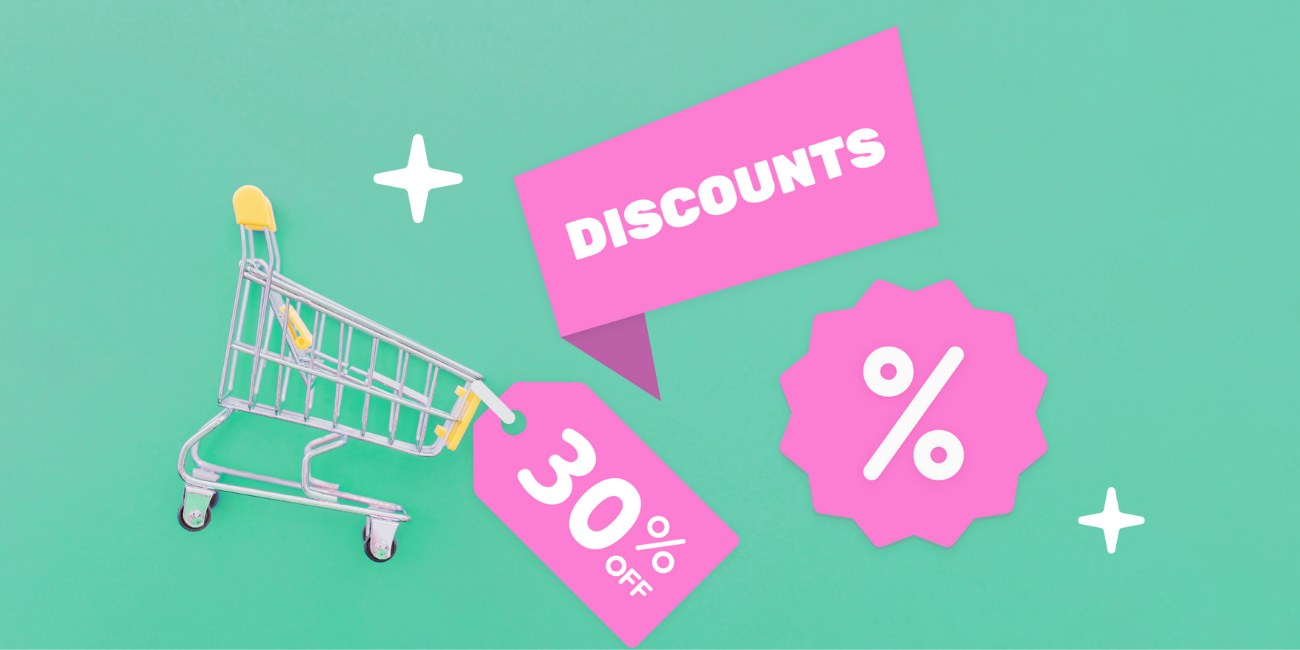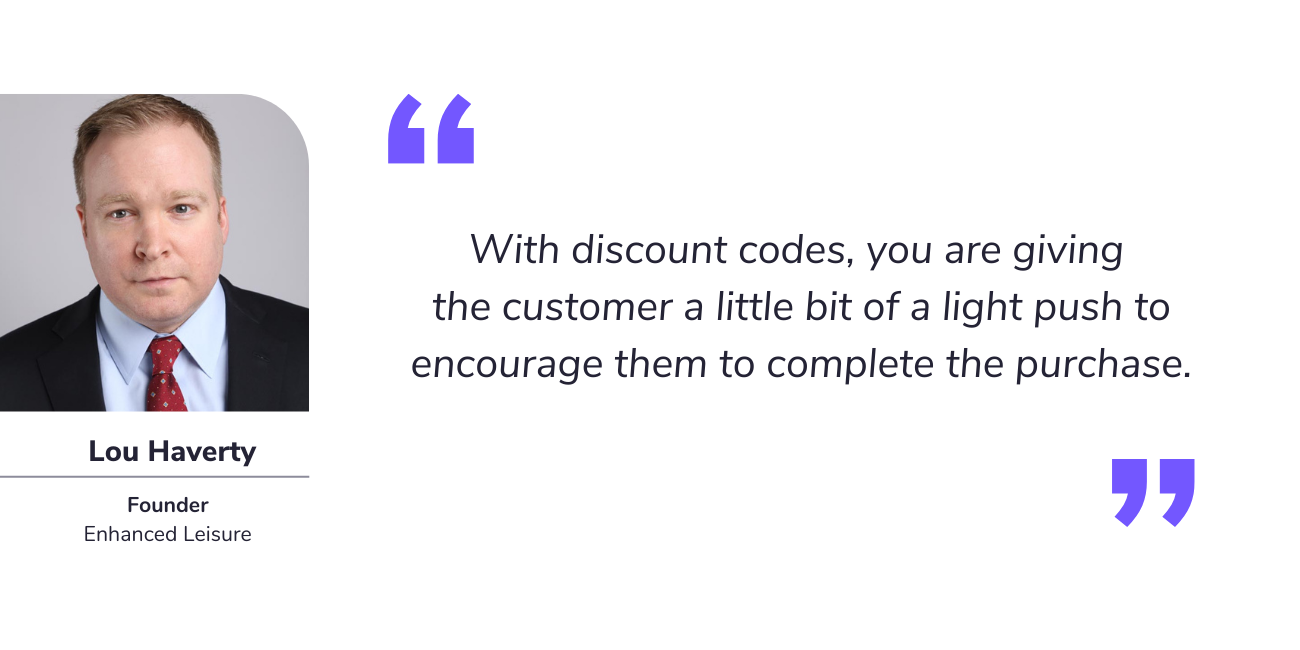If you own an e-commerce business you are probably already using discount codes. But have you ever stopped to analyse how well your discount code strategy is actually working?
We talked to e-commerce expert Lou Haverty, owner of Enhanced Leisure for the lowdown on discount codes. He shared great tips on how to maximize the potential of discount codes on your website.
Keep reading to grab the tips for your e-commerce store.
What is a discount code?
Discount codes are usually a combination of numbers and letters that enable a percentage or amount off of a customer’s order. The purpose of this code is to compel the customer to press the buy button with a discount incentive.

The key component with discount codes is that the customer is already interested in the product. Discount codes are an effective way to push customers to buy now rather than later.
“With discount codes, you are giving them a little bit of a light push to encourage them to complete the purchase,“ Haverty says.
Benefits of discount codes
Discount codes are effective. There is no question about it. According to Wikiby, 50% of consumers are more likely to visit a store when they have a discount voucher.
Discount codes have other benefits too.
Discount codes can increase:
- Traffic
- Average order value
- Brand loyalty
- Brand awareness
However, the number one reason to use discount codes is definitely to increase revenue. Discount codes are great at attracting new customers.
In fact, 39% of shoppers say they bought a product for the first time from a new brand due to a discount coupon.
If done correctly, these customers can turn into returning buyers.
Strategies for optimising your discount code strategy
You may think that you just need to generate the code, market it to your customers and you’re off to discount code success. Not quite.
If you want to get the most out of your discount code strategy it requires a bit more planning and testing.
“Discount codes sound simple, but it’s extremely complicated and subtle to actually implement them,” Haverty explains. “I'm constantly looking at the way I am using discount codes and evaluating the results.”
One challenge that Haverty ran into when trying out different ways to distribute discount codes is getting customers to take action. Haverty has done a lot of A/B testing to see which distribution channels and offers work the best for his store.
“You can test two options and see which one has a better conversion rate for getting someone to take the discount, “ he said. “It's like fine-tuning a radio. So, I haven't really settled on one specific way to do it yet.“
For example, you can test out if the discount codes that you advertise on social media lead to more checkout conversions or if the discount codes you offer on your website or through a custom QR code convert better.
Does a pop-up discount code or a banner discount code work best for your shop?
You can also test to see if a discount percentage, like 10% off, or a flat rate discount amount, like 5€ off total order, converts better.

Consider the discount code offer options
When you implement a discount code strategy on your e-commerce store you should start by deciding what offers you want to include in your discount code campaign.
Some popular discount code offers:
- Percentage based discount
- Amount based discount
- Free shipping offer
- Complimentary gift with purchase
The best discount code option for your e-commerce store depends on the type of products you are selling and the value of the products.
Usually, it is not a good idea to give a percentage-based discount if your store sells only high-value items. In this case, a percentage-based discount will get too costly.
For example, if your product costs more than 1,300 euros, a 20% discount would mean 240 euros off the resale price. With expensive products, a better choice might be an amount-based discount, such as 100 euros off with purchase.
Narrow down products to include in discount offer
Once you have chosen your discount code offer, you should consider which products you want to include in your discount campaign. You might ask: ’Why don’t I just include all the products?’
Here’s one reason why:
There could be supply chain issues with certain items. It wouldn’t be smart to push more people to buy these items if you are unable to meet the rising demand. Haverty says:
“That is why it is important to be able to use the discount code with certain products and not other products,”
Select the validity time of the discount code
Another important thing to consider is how long you want the discount code to be valid. For certain low-value items, 20 minutes can be enough time to push the customer to make the purchase decision.
In this case, a sense of urgency is beneficial.
On the other hand, for more expensive items, the customer’s buying decision isn’t as instant. They need extra time to decide to buy.
This is because when a customer is buying something pricey they want to conduct more research.
“I have certain products that naturally fit into time constraint discount offers,” Haverty says. “But for example, pool enclosures, which are much more expensive products, have a longer buying cycle. So, people want to call or chat before making a decision. Higher value items will take longer to buy.”
Decide how to promote discount codes
Once you have decided on the discount offer and products to include in your campaign, it is time to come up with a plan on how to entice your customers.
Here are some popular ways to promote discount codes:
-
Pop-ups
-
Discount wheel
-
Banners
-
Social media posts
-
Live stream videos
Choosing one of the above ways to display your discount codes will depend on who you target and what your main goals are.
For example, social media might be a good discount code distribution channel if your goal is to gain new customers.
On the other hand, targeted pop-ups work well for existing webstore visitors who have already been to your site but have yet to make a purchase.
Displaying discount codes during a live shopping event is a good choice to attract more viewers to your live stream.
Offering the discount voucher exclusively during this event gives an incentive to viewers to use the unique opportunity to steal a deal. In this case, you should also tease the reveal of the discount code on your social media campaigns.
Haverty recommends testing the whole gamut: pop-ups, chatbot, and discount wheels. All of them have proven to be good ways to display discounts for his e-commerce shop.
Haverty decided to try out the discount wheel to see if he could stand out against competitors. It’s a simple form of shoppertainment.
“The discount wheel is pulling people out of the pattern that they're in. It does a better job of capturing people's attention than a regular pop-up,” he says.
However, the discount wheel can come with some unwanted side effects, Haverty says.
Visitors may return to your website to play the game from a different browser. If they repeatedly receive an unfavorable prize, they may get frustrated with your website as a whole.
This is why Haverty decided to rig the game in the player's favor. He makes sure that each visitor playing wins the highest discount.
“The visitors will think ‘I won. I got the best amount.’ That will give the strongest incentive to get a sales conversion.”
Looking for more advice from eCommerce experts?
If you wish to get more tips from eCommerce experts, check out our blog on Cross-selling Like a Pro.
